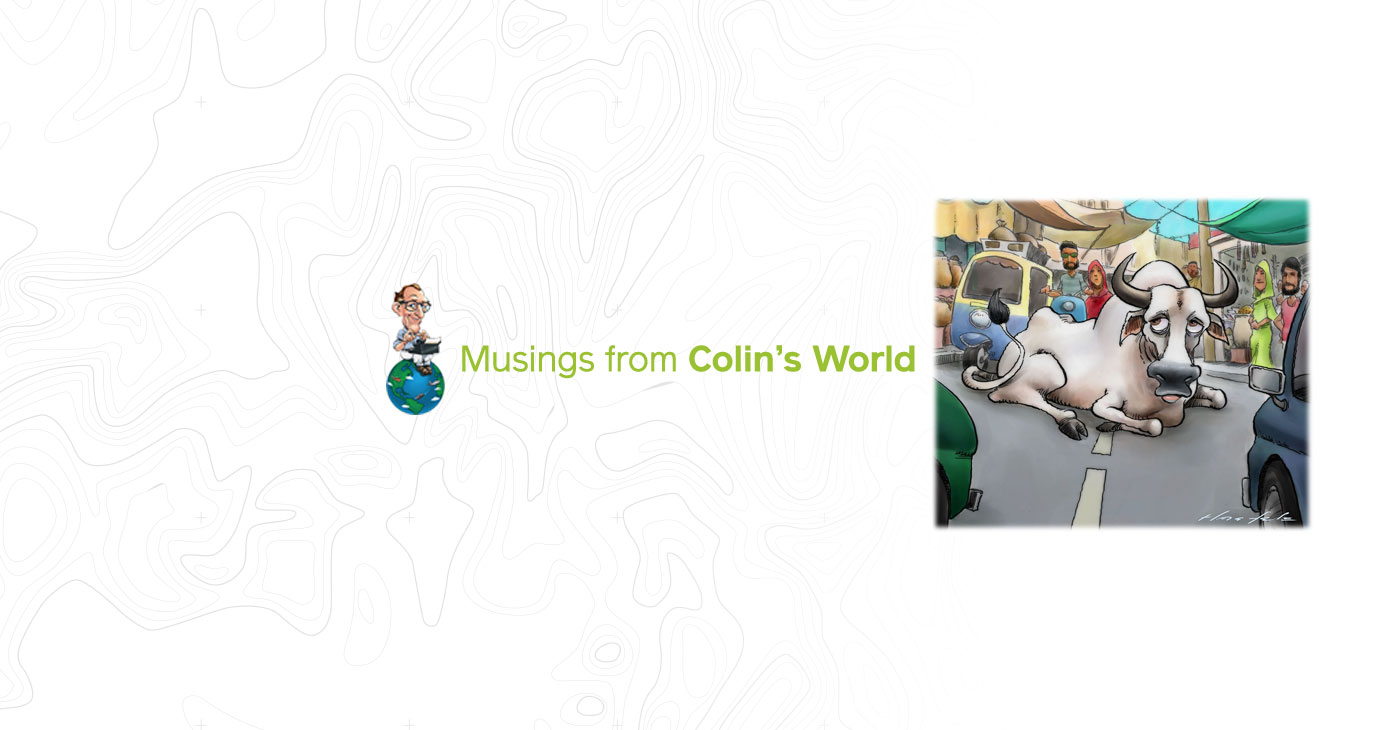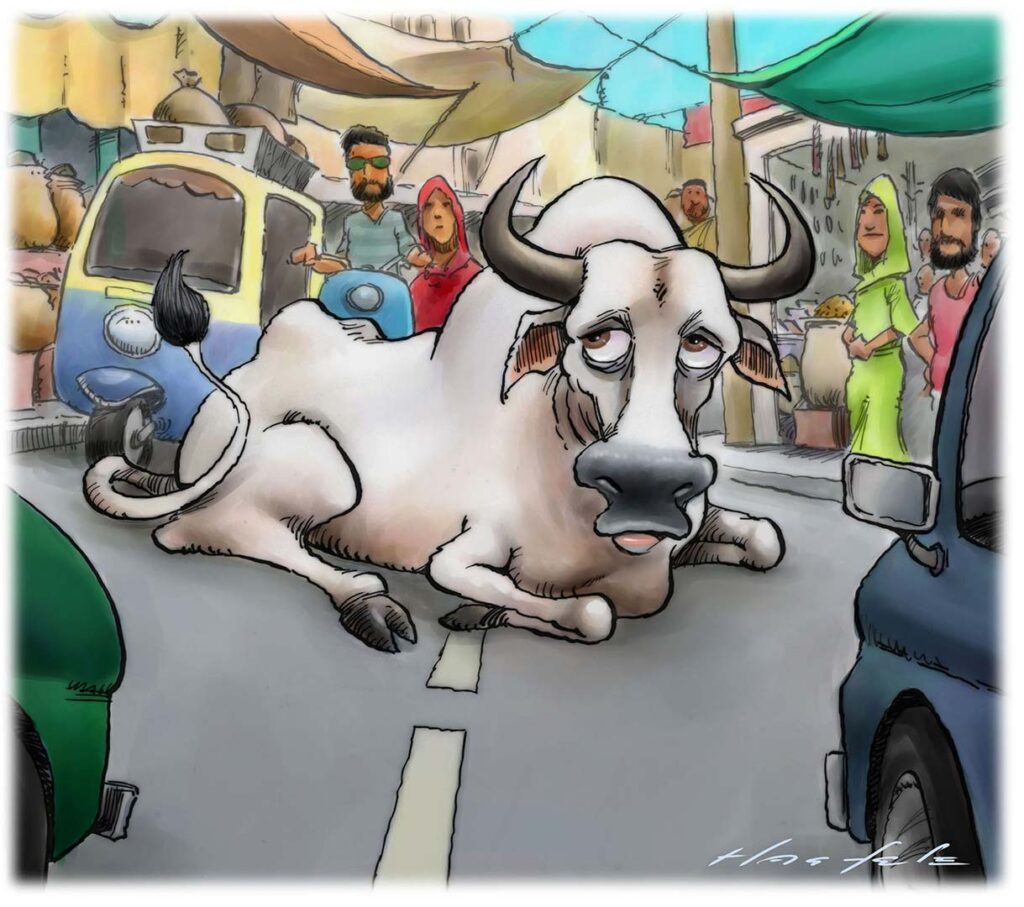
Traveling for me is like falling in love. When I go to a foreign place, I am often swept away by its charms and fall under a spell of infatuation. That was certainly the case with India. What an enchanting country! It is a place that can overwhelm you with an endless outpouring of fascinating impressions.
India seems essential for those who aspire to be world travelers. It’s the source of many of the primary elements of world culture. It’s mysterious, vast. Its history is deep and impenetrable. India is more than just a country, it’s a world, or many worlds. You can’t expect to take in India in a single trip.
I took an introductory tour of Northern India built around the Golden Triangle of the cities of Delhi, Agra, and Jaipur, with a few other places thrown in, including the incomparable Taj Mahal.


India is a giant mosaic of multitudes of things. It’s physically huge, but also culturally and historically dense. It’s about a third the size of the continental United States. The subcontinent is larger than Western Europe.
India compares in diversity to Europe. During most of its history, land transportation was no faster than a horse, which only the richest could afford. Before railroads, the vast majority of India’s rural population spent their entire lives within a few dozen miles of home.
If two villages were 50 miles apart, few villagers would ever travel from one to the other. So, while they may look close on the map to the modern eye, they have evolved independently for thousands of years and can be quite distinct from one another. If you apply that concept to the entire subcontinent, you can begin to get an idea of the tremendous variety within India.
There is evidence of human life in India going back hundreds of thousands of years. Some Madrasian tools found at Attirampakkam have been dated to 1.5 million years. These timespans sound more like geological ages than periods of human history. But when looking at the overall dimensions of Indian life, this is what we are looking at.
Artifacts of organized civilization have been found as early as 7570 BCE. The ancient land of India has seen many empires come and go. The British Crown ruled India from 1858 to 1947, but although Britain headed the colonial government, India’s culture may have had more of an effect on Britain than the other way around. It’s a tendency that plays out repeatedly in history, such as when Rome conquered Greece, but Greek culture conquered Rome. When Britain colonized India, the influence of India on British culture was profound.
I think of writers like Orwell and Kipling, who were born in India and whose world views were shaped by the experience of living at the juncture of Indian and British cultures.
Times when cultures collide and mix produce periods of cultural flowering. We may be in such a time now, with electronic media and modern transportation bringing all the cultures of the world together. It causes a lot of tumult, but it also produces cultural hybrids and innovation.
Hinduism started in India around 3,500 years ago and still thrives today. It had a powerful effect on Western thinkers and writers, such as Schopenhauer, Emerson, Thoreau, William Blake, Yeats, and even on quantum physics.
Buddhism began in India about 2,500 years ago and spread to China, Japan, Southeast Asia and then to Europe and America. Buddhism and Yoga are increasingly mainstream in America; in India they go back thousands of years. When you go to India, you go to the source of many of the fundamental elements of world culture.
About half of the world speaks an Indo-European language, traceable to early Indian Sanskrit. That category includes the Romance languages, the Germanic languages, Russian, Persian, Hindi and Punjabi. The field of modern linguistics originated in India with the study of classical Sanskrit.
India continues to be a major force in today’s world. In 2023, India surpassed China as the world’s most populous country. While China’s economic strength has been built on cheap factory labor, India has gained prominence as a strong contributor to the high-tech industries.
A number of Silicon Valley tech firms have been started or managed by people of Indian origin. The Indian cities of Bangalore and Hyderabad now rival the Silicon Valley as centers of new technology. As strong as India’s contribution to world culture has been historically, its influence on the world stage may be at its peak now.
As the world’s largest democracy, India has what Alexis De Tocqueville wrote about democracy, “a kind of tumult, a confused clamor… an all-pervading and restless activity, a superabundant force, and an energy which is inseparable from it.”
In India today you encounter India’s version of a kind of cultural cross-fertilization that is happening all over the world now. Cultures are colliding and meeting everywhere. But while some have feared that this cultural globalization would melt all cultures into a dull, homogenized world culture, that is not what I am seeing. On the contrary, the cultural encounters preserve and revive cultural traditions at the same time that they produce streams of recombinant new creations and innovations, an endless variety of novelty – new ideas, styles, inventions … newness!
Observing these kinds of cultural collisions around the world is one of the great pleasures of traveling today. It’s also a reason to keep traveling, because places you visited 20 years ago will be different next time.
Experiencing that emergent international culture is especially exciting in India because human history dates back farther there than almost anywhere. India today represents a great blending of Eastern and Western cultures that has been fermenting at least since the days of the British Raj, and is now charging vigorously into the current technological age.
My memories of India do not return to me in a neat chronological order, as in the description of an itinerary. Rather, in character with India itself, they come as a flood of kaleidoscopic clusters and splashes of impressions. The memories stream through my head in chaos and cacophony, riotous color, constant assaults on the senses that challenge habitual ways of looking at things.
You quickly become used to the ways of India, such as the fact that cows pretty much have their run of the place, and if a cow decides to take a rest in the middle of the street, the cars, wagons and pedestrians just respectfully go around the bovine.
I was taken aback to see women working on construction crews while clad in blindingly bright sarees, those pieces of woven fabric elaborately draped around the female figure.
I saw temples that were magnificently colossal, but also ornate down to the most intricate detail, such that they almost required a magnifying glass to see their tiniest features.
I was struck by how sensuous the culture is. The ancient art is unashamedly romantic, as are the movies of Bollywood today.
I had never seen luxury hotels of the standard I experienced in India. The Oberoi Vilas series takes luxury to a such a stratospheric level that someone suggested creating a six-star rating to accommodate it. The service level was also superlative. An Indian friend told me, “In our culture, the guest is king.”
Experiencing the Taj Mahal was otherworldly. To actually see that magnificent structure in person is unreal, or superreal. I was able to stay in the Amarvilas hotel, where I could see the Taj Mahal from my room. It was mind-blowing. I didn’t want to sleep. I wanted to spend the night on my balcony just gazing at it.
I let the sound system in my room play all night, music that was a kind of east-west fusion with Indian instruments like sitar and tabla but in Western song forms. It set the mood perfectly, as an embodiment of India itself today, a blend of East and West and everything.
Your Humble Reporter,
Colin Treadwell
Please visit:
Our Sponsor
